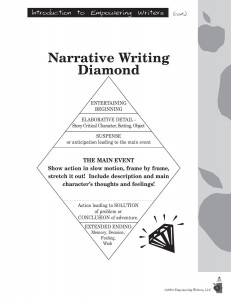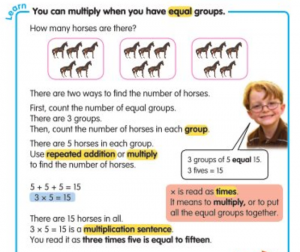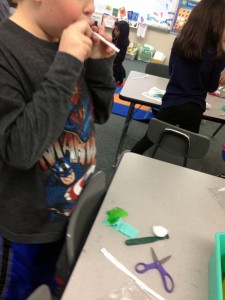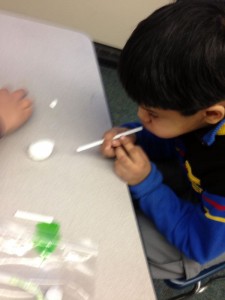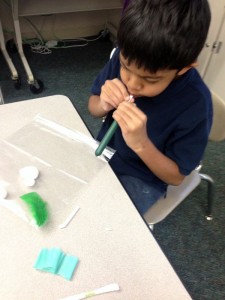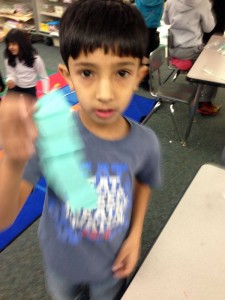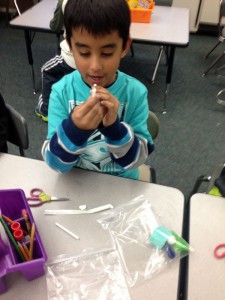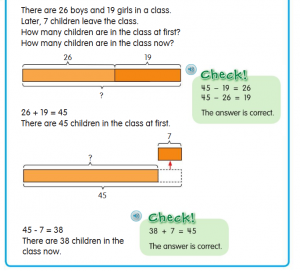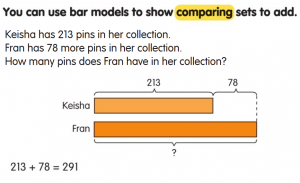Posted by kavery508 | Posted in Uncategorized | Posted on December 15, 2014
Please note: Our blog will be taking a break for the holidays, and will return on January 5. In class, there will be no homework assigned nor math facts/spelling quizzes given on the week of December 22. I wish you all the very best this holiday season, plus safe journeys and a prosperous New Year!
 Our CAFE focus this week is on Inferring, which is a strategy we use all the time to help us understand what we’re reading. When we infer, we use our schema (what we already know about something) and combine it with clues from the text to understand something new. Consider these lines from Eloise Greenfield’s poem Things: Went to the beach/Played on the shore/Built me a sandhouse/Ain’t got it no more. My schema tells me that at the beach we build sandcastles, which is what she likely means, and sometimes the ocean comes and washes them away–that’s why the speaker “Ain’t got it no more.” Kids and grownups infer all the time in real life, for example: Snow is in the forecast. When the phone rings at 5:30 AM we can infer school will be delayed or cancelled! It’s smart to catch it when it happens and ask “How did you infer that? What were your clues?” Here is a site that, while designed for teachers, has lots of great info and links on inference: http://www.minds-in-bloom.com/2012/02/tips-for-teaching-inference.html
Our CAFE focus this week is on Inferring, which is a strategy we use all the time to help us understand what we’re reading. When we infer, we use our schema (what we already know about something) and combine it with clues from the text to understand something new. Consider these lines from Eloise Greenfield’s poem Things: Went to the beach/Played on the shore/Built me a sandhouse/Ain’t got it no more. My schema tells me that at the beach we build sandcastles, which is what she likely means, and sometimes the ocean comes and washes them away–that’s why the speaker “Ain’t got it no more.” Kids and grownups infer all the time in real life, for example: Snow is in the forecast. When the phone rings at 5:30 AM we can infer school will be delayed or cancelled! It’s smart to catch it when it happens and ask “How did you infer that? What were your clues?” Here is a site that, while designed for teachers, has lots of great info and links on inference: http://www.minds-in-bloom.com/2012/02/tips-for-teaching-inference.html
We’re finding the hardest part of narrative writing to be stretching out the main event; therefore, this will be the focus of writing instruction this week and next. The students are largely adept now at creating a beginning/middle/end to their life stories: I got the basketball. I threw it. I scored! What’s required next is for young writers to really slow down the action and toss in some specific word choice: I grabbed the basketball with both hands and dribbled it twice. I looked up at the net hanging above me. I aimed carefully and raised the ball above my head. I bent down, then jumped up high, throwing the ball as straight as I could. This kind of elaboration is necessary to produce writing of the caliber required by state standards in grades two and above.
 In math, we have worked hard at problem solving that requires students to think deeply about problems and apply efficient models and strategies. I have created problems for this week’s homework that help direct students in their thinking. They are challenging, and are similar to problems being worked on in school. The cover sheet for each homework, Mon-Wed, is the same. It reviews how to make each kind of bar model correctly and suggests when to use each. Each problem on the next 2 pages require creating 2 correct bar models (including labels and numbers); using addition or subtraction to solve; checking the work with subtraction or addition; and writing the answer. We will wrap up this initial chapter on bar modeling this week and take the test on Chapter 4.
In math, we have worked hard at problem solving that requires students to think deeply about problems and apply efficient models and strategies. I have created problems for this week’s homework that help direct students in their thinking. They are challenging, and are similar to problems being worked on in school. The cover sheet for each homework, Mon-Wed, is the same. It reviews how to make each kind of bar model correctly and suggests when to use each. Each problem on the next 2 pages require creating 2 correct bar models (including labels and numbers); using addition or subtraction to solve; checking the work with subtraction or addition; and writing the answer. We will wrap up this initial chapter on bar modeling this week and take the test on Chapter 4.
We will then begin Chapter 5, which is an introduction to multiplication and division. In case you’re following along in the student book at home, we will do the Chapter Opener beginning on p. 128. The book assumes our kids have prior knowledge on this stuff, but since we used a different program, I’m taking time this week to teach them the basics of multiplication (sets; equal groups; addition of groups as multiplication). I’ve added the Math in Focus “Think Central” link to the Parent Resources tab above. For directions how to use it to access the student edition ebook, refer to the green paper sent home last month, or refer back to my Week 13 blog post.
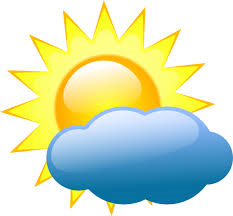 In science, students are learning the properties of air and how to prove it is there (it can fill a container/be captured; it is evident from the way stationary objects are moved/blown; it can be manipulated).
In science, students are learning the properties of air and how to prove it is there (it can fill a container/be captured; it is evident from the way stationary objects are moved/blown; it can be manipulated).
This week we will also learn that air can be compressed, and the resulting air pressure causes reactions. Here’s a link to our science program’s overview page for this unit: http://www.fossweb.com/delegate/ssi-wdf-ucm-webContent?dDocName=D980854
And here’s some awesome investigations you can do at home! http://www.superchargedscience.com/documents/Top%20Ten%20Air%20Pressure%20Experiments%20to%20Mystify%20Your%20Kids.pdf
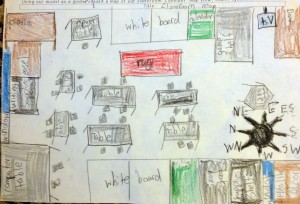 In Social Studies, we have been applying our knowledge of scale, orientation, symbols, labels, and view when making classroom maps. Check out the terrific example above! Notice how the places in the classroom are draw to relative scale, with the center of the room in the center of the map. The view is a bird’s eye view for the most part, and objects/places are symbolic (e.g. just a shape) and labeled. The compass rose is placed correctly to show position and is labeled, too. Students will be using their maps to hide a treasure and lead other students to it by writing a list of directions from one place to another using cardinal directions. The kids are totally getting this! Try doing the same by making maps of places at home!
In Social Studies, we have been applying our knowledge of scale, orientation, symbols, labels, and view when making classroom maps. Check out the terrific example above! Notice how the places in the classroom are draw to relative scale, with the center of the room in the center of the map. The view is a bird’s eye view for the most part, and objects/places are symbolic (e.g. just a shape) and labeled. The compass rose is placed correctly to show position and is labeled, too. Students will be using their maps to hide a treasure and lead other students to it by writing a list of directions from one place to another using cardinal directions. The kids are totally getting this! Try doing the same by making maps of places at home!
![]() You’re invited! Our class will be performing songs and poems with a Winter Theme in the cafeteria on Friday, December 19, at 9:30 (snow date: Monday, December 22, 9:30). We will remain in the space after, for photo opps and congratulations. <”) Please come: family and friends welcome! This is our Winter Celebration, and takes the place of a class party. Per district recommendations, please do not send in food or drink to share, though you are of course welcome to send in something special, nut free, for your child to enjoy at snack time.
You’re invited! Our class will be performing songs and poems with a Winter Theme in the cafeteria on Friday, December 19, at 9:30 (snow date: Monday, December 22, 9:30). We will remain in the space after, for photo opps and congratulations. <”) Please come: family and friends welcome! This is our Winter Celebration, and takes the place of a class party. Per district recommendations, please do not send in food or drink to share, though you are of course welcome to send in something special, nut free, for your child to enjoy at snack time.

